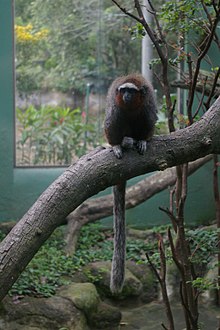Ornate titi
| Ornate titi | |
|---|---|
 |
|
| Ornate titi in Cali Zoo. | |
| Scientific classification | |
| Kingdom: | Animalia |
| Phylum: | Chordata |
| Class: | Mammalia |
| Order: | Primates |
| Family: | Pitheciidae |
| Genus: | Callicebus |
| Species: | C. ornatus |
| Binomial name | |
|
Callicebus ornatus (Gray, 1866) |
|
 |
|
| Ornate Titi range | |
The ornate titi (Callicebus ornatus) is a species of titi belonging to the p. moloch group, and is the smallest member of the Pitheciidae family, which also includes uakaris and saki monkeys. As it is a member of this family, it is classified as a type of New World monkey. It is endemic to eastern Colombia, and the only member of the p. moloch group to occur north of the Rios Amazonas/Solimes/Napo axis, living at least 350 km away from the closest other member, the white tailed-titi (Callicebus discolor), which lives in the south of Colombia. It was once classified as the same species as the white-tailed titi, but is now officially recognized as its own species. The ornate titi is also terrestrial.
The ornate titi is present on the IUCN list of endangered species, being recognized as “Vulnerable”, and having a general decrease in population trends.
The ornate titi has a thick, dense, fluffy, coat, with white ears and forehead, and grey hands and feet. The rest of the body is a bright chestnut red, apart from the tail, which is a dark-reddish brown or black, becoming white at the tip, and, similar to most titi species, is longer than its body. Male and female ornate titis do not differentiate significantly in appearance, however, generally, females tend to be larger, with an average male body length of 633 mm, and an average female body length of 752 mm.
The ornate titi lives in the department of Cundinamarca (Medina) north as far as the lower Ro Upa/Ro Meta, and south into the department of Meta, along the base of the Cordillera Oriental and the Sierra de la Macarena to the Ro Guayabero/upper Ro Guaviare. It mainly inhabits the tropic and sub-tropic levels of the forest, generally preferring areas with dense vegetation, such as thickets, tangles, thorny underbrushes and wet or even waterlogged areas.
The ornate titi tends to sleep in vine tangles located on small branches of trees, generally preferring to be at least 15m off of the ground. Like other members of the moloch group, the ornate titi is considered tolerant of seasonal flooding and disturbances within its habitat, and is commonly found living in areas of forest disturbed by humans, in particular thriving on highly disturbed habitats. However, due to the continuous expanding of human settlements and therefore declination of both the size and quality of the ornate titi’s habitat, the presence of the species has become severely fragmented, with the current approximate area of habituated land around 20,000 km a decline of 30% in the last 24 years, and has been listed as Vulnerable by the IUCN since 1994 and is listed on Appendix II of CITES.
...
Wikipedia

